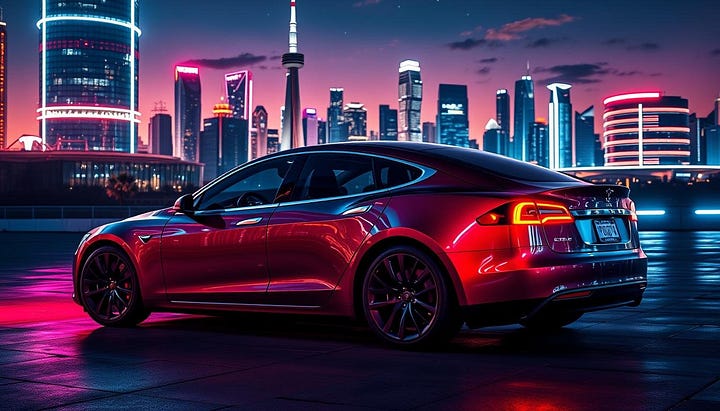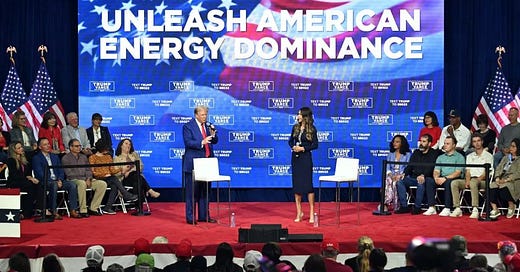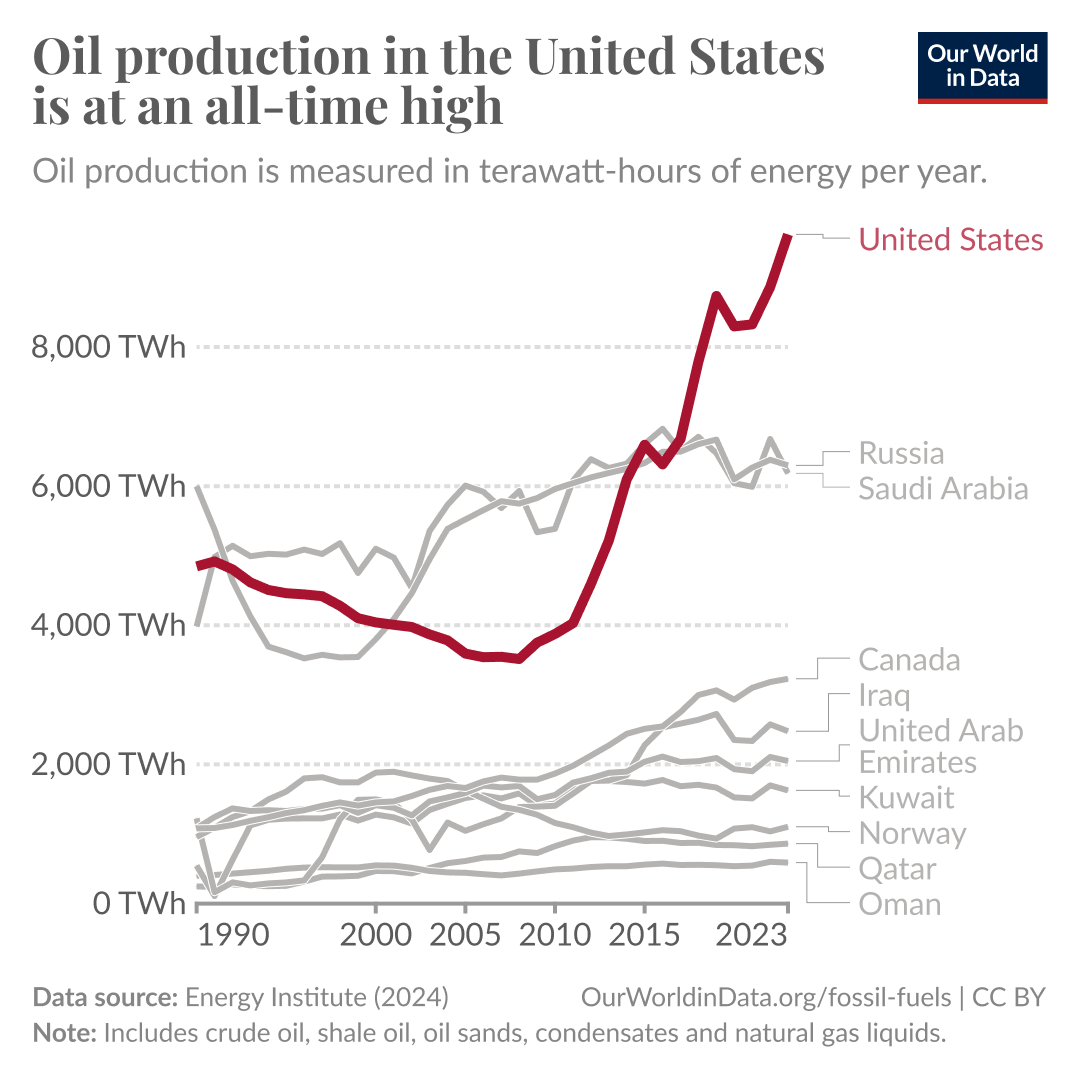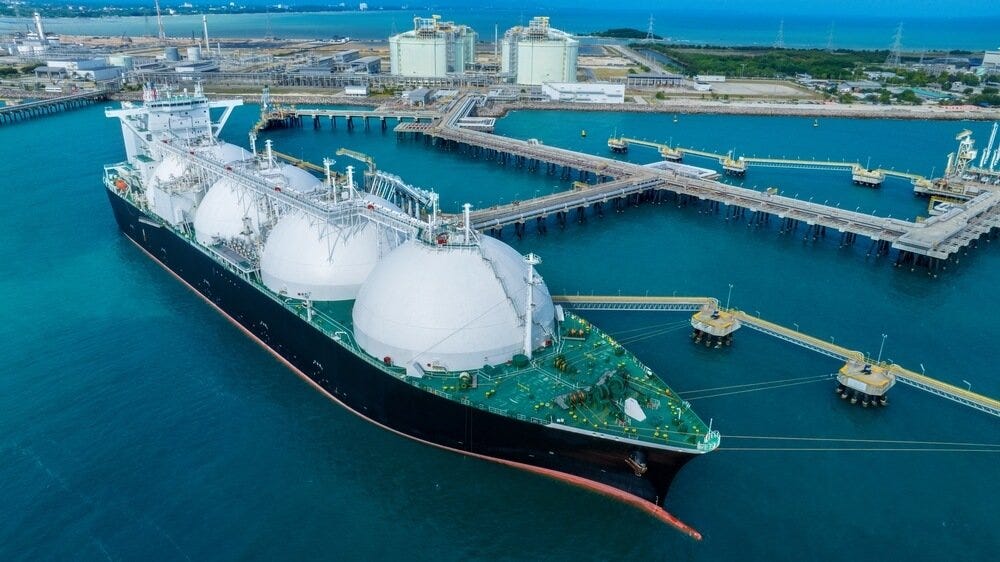America: The World’s Energy Powerhouse
For a lifetime, American elites preached "the end of oil" and permanent dependence on foreign energy sources. But innovation made America the world's top producer. Trump is taking it next level.
by Rod D. Martin
February 20, 2025
For decades, the left peddled doomsday tales about American energy. They claimed the world had reached “Peak Oil”, that oil and natural gas would soon be gone, and that windmills and solar panels (but not nuclear! Definitely NOT nuclear!) were the only ways to stave off civilizational collapse.
This was “settled science”. Ask anyone from Paul Ehrlich and the Club of Rome to Al Gore and T. Boone Pickens (who, unlike the others, had the decency years later to admit he’d been wrong and that his proposals would have been an economic disaster had they been adopted).
No one asked how many of these tall tales were funded by Middle Eastern sovereign wealth funds and American oil companies just hoping to jack up prices; or “Green entrepreneurs” hoping to make bank by forcing the public into new fuels and infrastructure they’d then provide. No one looked too closely at where the Environmental Defense Fund’s or Greenpeace’s donations came from. And no one explained why, if fossil fuels were running out anyway, the environmental lobby kept trying to regulate them into oblivion.
One might almost believe that well-placed elites were profiting from panic, much as those same folks line their pockets with the proceeds of carbon credits and assorted other scams.
And yet, here we are: the U.S. is not only the world’s largest producer, it’s the world’s largest exporter, amazing for a country whose production was continually dropping for decades, and who had legally banned exports. Today America hasn’t just achieved a long-ellusive “energy independence” — it’s energy dominant.
Thank the free market: rising prices in the 2000s produced entrepreneurial techological innovation (fracking), which has now completely remade the world. Yes, Socialists, Capitalism solves nearly all problems, innovation eliminates scarcity, and wealth isn’t in the ground but in the mind.
And now, in typical Trumpian fashion, the President is taking that next level, seeking to permanently replace Russia and OPEC in a new Golden Age of American exports.
Here’s where things stand:
America now produces more oil and gas than anyone — more than the Saudis, more than the Russians.
We export more refined petroleum products than almost any country has ever exported crude.
Instead of “exporting” a staggering $700 billion per year to import energy from our enemies (as we were doing in the late 2000s), the world is now “exporting” that money to us in exchange for cheap, high quality U.S. supply.
And the biggest news of all? The U.S. isn’t just the biggest producer of oil and natural gas — we’re now the world’s biggest exporter too.
LNG: America’s Geopolitical Game-Changer
American natural gas has always been plentiful and cheap. The problem has been transportation. Prior to the development of affordable LNG (liquefied natural gas) terminals and tankers, gas was pipeline-bound, and America is a bit of an island.
Enter fracking, which changed the cost-benefit of absolutely everything.
Predictably, under Joe Biden’s “Green New Deal” Democrats, America’s natural gas boom was kneecapped. Bowing to the climate cult, Biden froze new LNG export terminal approvals, cutting off the possibility of expanding our reach in global markets at precisely the moment that Europe found itself largely cut off from Russian gas. (If you think the Ukraine lobby is powerful among Democrats, wait till you meet Climate Justice.)
But President Trump just reversed that decision. Terminals are being permitted, meaning America can supply cheap, cleaner energy to a world held hostage too long by hostile players.
Because energy isn’t just an economic juggernaut — it’s a strategic weapon. America learned that in the 1970s when for political aims, OPEC embargoed us twice, throwing the economy and the NATO alliance into chaos. Reagan saw that two could play that game, and teamed up with the Saudis to collapse oil prices, depriving Russian exports of profitability and bankrupting the Soviet Empire.
Over the past two decades, Europe (and especially export-powerhouse Germany) made itself dependent on Russia for oil and gas, thus undermining its own security and making itself vulnerable to blackmail. When war broke out in Ukraine, the EU faced an impossible choice: bankroll Putin’s war machine or freeze in the dark.
Enter America.
With the U.S. stepping in, Europe kept the lights on. And with Trump’s reversal of Biden’s LNG freeze, we’re about to supercharge our role as the world’s energy lifeline.
Right now, the U.S. is pumping out 15 billion cubic feet per day of LNG. To put that in perspective, that’s enough to power Japan for two full days, every single day. The world’s third largest economy, Japan is wholly dependent on foreign energy. Its supply line runs 7,000 miles — 20 days at sea, one way — from the dangerous Middle East past hostile China. It’s alternative? Russia.
Why not supply that from Alaska instead? Cheaper, safer, and no more giant subsidy to actual or potential enemies.
And the best part? As greater transport comes available allowing production to greatly increase, this is just the beginning.
Wall Street sees what’s coming. Morgan Stanley projects U.S. LNG capacity will double by 2029. Why? Because the world needs our gas, Trump is turning it loose, and the market knows it.
Of course, America isn’t the only player in this game. Qatar is aggressively expanding its own LNG capacity, aiming to double its output by 2030. Likewise, if the war with Russia can be peacefully ended, Russian supply is likely to come back into the market.
Moreover, this is a market dominated by long-term contracts. U.S. LNG projects rely on 20-year take-or-pay contracts. These deals assure investors that massive, capital-intensive terminals will actually be profitable.
So we’re in a race — one that America must win, not just for its own sake but for its allies and its global position.
This is why Trump’s move is critical: We need to lock in buyers now. Japan is already stepping up. Japanese Prime Minister Shigeru Ishiba has pledged to double Japan’s imports of U.S. natural gas, bolstering our role in the global supply chain.
China and India, two of the world's largest energy consumers, are also prime targets for U.S. LNG. They need vast quantities of reliable energy, especially India as its population mushrooms and grows wealthier. The U.S. has a golden opportunity to secure long-term contracts with these nations, ensuring that our exports remain in high demand for decades to come. This is a largely-unseen angle in Trump’s tariff strategy: trading U.S. market access for American energy exports.
Trump gets it. That’s why he’s talking not about the old “energy independence” slogan but rather actual “energy dominance”. There’s a better world to be had if free countries don’t have to kowtow to Moscow, Riyadh, and Tehran.
AI Data Centers and Domestic Demand
It’s not just international demand driving the boom — America itself is going to need a lot more energy than ever. Artificial Intelligence and data centers are ravenous for power. So are those fleets of EVs the Greens demand. The big tech companies that once virtue-signaled about 100% renewables are now realizing the hard truth: solar and wind won’t cut it.


Some have opined that China’s DeepSeek, which uses far less power than Grok or ChatGPT, changes that equation. They’re wrong. Even if DeepSeek lives up to its potential, and even if every other AI player adopts its approach, supply creates demand: the world will multiply its use of cheaper AI, and energy demand will grow.
Nuclear is the obvious answer, but crippled by public attitudes and regulatory nightmares. New projects in the U.S. are extraordinarily difficult (something which must change). But for now, clean cheap natural gas is the answer:
100 years of U.S. reserves — that we know of so far.
Dirt cheap prices: $4 per million BTUs here vs. $15 globally.
Much cleaner than coal, keeping emissions down while keeping power on.
Much more reliable than renewables, making it the backbone of a stable grid.
A Once-in-a-Century Opportunity
The U.S. has so much natural gas that sometimes, prices actually go negative — producers literally can’t give it away, because of limited transport capacity. Worse still, for decades companies used to burn off the gas produced by their oil wells. That’s an insane waste of economic power.
The solution? More pipelines, and more LNG terminals, now.
The President understands that energy isn’t just an industry — it’s the foundation of modern civilization, as well as American power, prosperity, and security. He’s setting the stage for an economic and geopolitical transformation.
The economic windfall from increased LNG exports will provide an enormous, much-needed boost to American jobs, local economies, and everyday Americans, keeping energy prices low for U.S. consumers. The industry is already seeing billions in private investment pouring into new projects along the Gulf Coast, further cementing America’s role as the global leader in energy production.
Think about the difference:
Under the Uniparty, America sent $700 billion per year to foreign energy states, often enemies.
Under Trump’s “energy dominance”, that money is coming here instead.
The global energy map is being redrawn, and America is holding the pen. The future belongs to those who control energy — and the U.S. is poised to lead for generations to come.
If you thought the 20th Century was “the American Century”, buckle up.
Recent articles:











If this article is too complex, watch Tommy Norris in LANDMAN, explain the facts of “oil life”, to the young inexperienced lawyer while they are standing under a giant wind turbine in the Texas desert.
It’s the best ever.
Great article. Thank you.